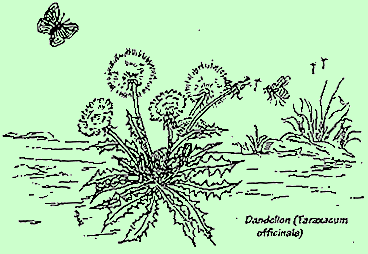|







|
. |
The Most Successful Plant ?


 You can cut it down with your lawn mower, drive over it growing in a crack
of your cement driveway, and it will survive! It has spread to every
continent but Antarctica. It flowers low, then rises to spread its
parachute seeds. It has been used for food, for tonic, for wine; so it is
both blessed and cursed. Children have made it into chain necklaces, and
made bouquets, and blown the many parachutes to watch them fly!
You can cut it down with your lawn mower, drive over it growing in a crack
of your cement driveway, and it will survive! It has spread to every
continent but Antarctica. It flowers low, then rises to spread its
parachute seeds. It has been used for food, for tonic, for wine; so it is
both blessed and cursed. Children have made it into chain necklaces, and
made bouquets, and blown the many parachutes to watch them fly!

 It is a whole bouquet, a composite flower. The outer ray flowers, which
look like petals, are actually five petals fused together; and the packed
short disc flowers in the center are each a complete flower with stamen and
pistil. Its roots penetrate the soil deeply and can survive drought, and
it is very hard to cut the root deep enough so it will not once more grow!
It is a whole bouquet, a composite flower. The outer ray flowers, which
look like petals, are actually five petals fused together; and the packed
short disc flowers in the center are each a complete flower with stamen and
pistil. Its roots penetrate the soil deeply and can survive drought, and
it is very hard to cut the root deep enough so it will not once more grow!

 Its bitter taste keeps grazing animals from eating it. It is believed to
be one of the "bitter herbs" mentioned in the Bible. It can be cooked and
eaten; from the roots a laxative can be made; and it has also been dried
for a Postum-like drink. Its gold in the spring flowering can be beautiful
and add brightness to the day. And we might as well enjoy it, for we are
stuck with it! What is it? --- The common Dandelion
(Taraxacum officinale).
Its bitter taste keeps grazing animals from eating it. It is believed to
be one of the "bitter herbs" mentioned in the Bible. It can be cooked and
eaten; from the roots a laxative can be made; and it has also been dried
for a Postum-like drink. Its gold in the spring flowering can be beautiful
and add brightness to the day. And we might as well enjoy it, for we are
stuck with it! What is it? --- The common Dandelion
(Taraxacum officinale).

-- by Dot K. Platt
Dandelions
 The dandelion is an ubiquitous member of the sunflower family, for there
are few places where it is not to be found. The mechanisms for survival
which have been provided for it through centuries of evolution make it a
plant capable of sampling many varied environments. Along the edge of
highways, it occurs everywhere except in the driest deserts. It has been
found at the edge of tundra country, and along the trails in deep forests.
In carefully mowed lawns, its growth is an appressed collection of leaves
which hug the ground successfully against the onslaught of the lawn mower.
In deep grassy meadows, it will send its leaves at an angle upward for
half a foot or more, and the flowerheads to well over a foot.
The dandelion is an ubiquitous member of the sunflower family, for there
are few places where it is not to be found. The mechanisms for survival
which have been provided for it through centuries of evolution make it a
plant capable of sampling many varied environments. Along the edge of
highways, it occurs everywhere except in the driest deserts. It has been
found at the edge of tundra country, and along the trails in deep forests.
In carefully mowed lawns, its growth is an appressed collection of leaves
which hug the ground successfully against the onslaught of the lawn mower.
In deep grassy meadows, it will send its leaves at an angle upward for
half a foot or more, and the flowerheads to well over a foot.

 Each leaf of the dandelion is folded along its middle. Since there is no
stem, the leaves arise from a root top. When even light rains fall, each
leaf will serve as a trough to direct water toward the central columned
taproot. A score of leaves will radiate out from a center, and no leaf
shades another more than the barest minimum from the sun, so as not to
interfere with the photosynthetic process of building more tissue.
Each leaf of the dandelion is folded along its middle. Since there is no
stem, the leaves arise from a root top. When even light rains fall, each
leaf will serve as a trough to direct water toward the central columned
taproot. A score of leaves will radiate out from a center, and no leaf
shades another more than the barest minimum from the sun, so as not to
interfere with the photosynthetic process of building more tissue.

 In the early spring, the buds will be forming in the center of the mass
of radial leaves, and when conditions are right and the bud is ready for
opening, the bud, which seemed to have practically no stalk, is now lifted
high into the air. Strangely enough, in well-clipped lawns, this may be
only three or four inches, but in deep grass meadows and along weedy trails
it may reach to over a foot. Here, high in the air, it is favored by visits
from insects which aid in the pollenation, and at the elevated position
winds readily pick up the pollen to blow it by chance to other flowers.
In the early spring, the buds will be forming in the center of the mass
of radial leaves, and when conditions are right and the bud is ready for
opening, the bud, which seemed to have practically no stalk, is now lifted
high into the air. Strangely enough, in well-clipped lawns, this may be
only three or four inches, but in deep grass meadows and along weedy trails
it may reach to over a foot. Here, high in the air, it is favored by visits
from insects which aid in the pollenation, and at the elevated position
winds readily pick up the pollen to blow it by chance to other flowers.

 After the flower has completed its blooming, the bracts around its base
fold forward and enclose the flower parts in a tight mass; the stem shrinks
and droops so that the flower with its fertile seeds awaiting ripening is
safe closer to the ground. After a few days, the seed heads are ripened,
and the stalk is raised again. The cells in the stalk greatly elongate,
raising the ripened seed head considerably higher than it was when in
flower. Slowly the tightly closed heads, now with ripened seeds, open and
the hundreds of elongated seeds, which had been tightly appressed by their
bases, are now exposed on the base, which assumes a hemispherical shape,
and so each seed projects at right angles to the surface of this base at
its point of attachment. On the top of each seed is a short slender stem,
on the top of which is a group of fine projections which spread out like
the ribs of an umbrella. At this time, the slightest breeze might pick up
some of these seeds with their little umbrella parachutes, and carry them
great distances to insure future generations.
After the flower has completed its blooming, the bracts around its base
fold forward and enclose the flower parts in a tight mass; the stem shrinks
and droops so that the flower with its fertile seeds awaiting ripening is
safe closer to the ground. After a few days, the seed heads are ripened,
and the stalk is raised again. The cells in the stalk greatly elongate,
raising the ripened seed head considerably higher than it was when in
flower. Slowly the tightly closed heads, now with ripened seeds, open and
the hundreds of elongated seeds, which had been tightly appressed by their
bases, are now exposed on the base, which assumes a hemispherical shape,
and so each seed projects at right angles to the surface of this base at
its point of attachment. On the top of each seed is a short slender stem,
on the top of which is a group of fine projections which spread out like
the ribs of an umbrella. At this time, the slightest breeze might pick up
some of these seeds with their little umbrella parachutes, and carry them
great distances to insure future generations.

 The tap root has been found to penetrate sometimes for many feet into the
ground, where moisture is extracted by numerous tiny thread-like roots which
project from the main stem. Such a deep taproot gathers moisture from the
depths, enabling the plant to survive long periods of drought.
The tap root has been found to penetrate sometimes for many feet into the
ground, where moisture is extracted by numerous tiny thread-like roots which
project from the main stem. Such a deep taproot gathers moisture from the
depths, enabling the plant to survive long periods of drought.

 This plant has a great defense against the efforts to eliminate it from
lawns with a knife blade. If the head is severed from the taproot near
where it sent out its leaves, a new top will likely be developed, which
will be multiple-headed and more vigorous than ever.
This plant has a great defense against the efforts to eliminate it from
lawns with a knife blade. If the head is severed from the taproot near
where it sent out its leaves, a new top will likely be developed, which
will be multiple-headed and more vigorous than ever.
 -- by Stanley B. Mulaik
-- by Stanley B. Mulaik
|
|

